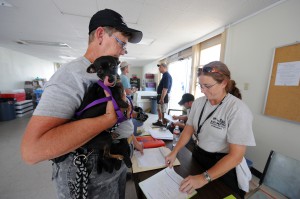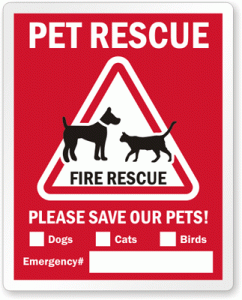Leave no pet behind: tips for pet evacuation in an emergency

A dog displaced by Hurricane Ike waits to be checked in at a local shelter set up by the Humane Society. (Photo by Jocelyn Augustino/FEMA, via Wikimedia Commons.)
We are a nation of softies – at least when it comes to our pets. Annual spending on pet products – mainly for dogs and cats – was one of the few areas in which consumer sales continued to increase while the rest of the economy went down, according to tracking by the National Retail Federation. We’re a nation that takes them to doggie daycare, buys them health insurance, and feeds them organic, gourmet food.
But no amount of daily doting can help during a disaster, and Superstorm Sandy brought a fresh focus to the often-overlooked needs of pets during emergency situations.
Throughout New Jersey and other states affected by the hurricane, many pet parents without their own transportation or pet-friendly location to seek shelter were forced to evacuate and leave their dogs and cats behind. Others simply refused to leave and risked their own lives.

Many pet parents stay behind to care for their pets: a situation that isn’t safe for anyone. (Photo by David Shankbone, via Wikimedia Commons.)
In light of this, the New Jersey Assembly Agriculture Committee recently approved a bill that would allow passengers to board public transportation with their pets during a state of emergency or evacuation.
From the ASPCA to FEMA, animal welfare and emergency preparedness pros say preparation is the key to making sure that all members of your family make it to safety during an emergency. Here are their basic recommendations for pet evacuation preparedness.
Identify your pets.
No one knows when a disaster might strike, and animals can become disoriented or confused during an emergency. Make sure that pets wear tags that include their name, your name, telephone number, an alternate contact, any urgent medical concerns and the vet’s contact information. Microchips – implanted in an animal’s shoulder area – are also an option.
Alert first responders.
In home-based emergencies such as a fire, it’s crucial that emergency response personnel know there are animals who need to be rescued. Time is critical to survival, so the ASPCA recommends using pet rescue stickers, conspicuously placed on doors or windows near doors.
The sticker should state the type and number of pets in the household and an emergency phone number. The association also notes that’s important to consider the safety of first responders, so if there is time during an evacuation, write “Evacuated” across the sticker before leaving the home.
Create an emergency pet evacuation kit.

Don’t forget the water bowls! Pack portable versions for each pet. (Photo from In the Company of Pets, via Creative Commons.)
You’ve got an emergency evacuation kit for the family – with a flashlight and all the other essentials, right? Well the Red Cross and the ASPCA recommend pet owners create another kit specifically for Kitty or Fido. It should include:
- First-aid supplies
- An extra leash, harness or carrier
- 3-7 days’ worth of canned or dry food
- Manual can opener
- Water and food bowls
- A two-week supply of medications
- At least 7 days’ worth of water for each pet
- Blanket
- A current photo of your pet (in case you are separated)
- Information on their feeding schedule and medical conditions, medications, behavior problems and veterinarian (stored in a waterproof container)
- A list of “pet-friendly” places (see below)
- A favorite toy
- Disposable litter trays and scoopable litter (for cats)
- Garbage bags
Make sure the kit is clearly labeled and that everyone in the household knows where it’s stored – preferably near a door.
Develop a “buddy system.”
Talk with neighbors or friends or family members who live close to your home and can help evacuate your pet if a dangerous situation arises while you are away from home. Provide the person with an extra set of keys, as well as the location of your pet’s emergency kit.
Plan a “safe haven.”
Did you know that Red Cross shelters don’t accept companion animals? It’s imperative that you have a plan for where you and your pets can go during an emergency. This could be the home of a friend or family member, a “pet-friendly” hotel, or a kennel or animal shelter that provides emergency shelter. The Red Cross notes that some hotels will waive “no pet” policies during an emergency.
Create a list of options, along with contact information for each, and place it in the emergency kit. The Animal Legal Defense Fund points out that if you need to use the resources of a shelter or foster home, it might be wise to have a foster care agreement form – templates are available here.
Want to learn more about how you can be a prepared pet parent? FEMA offers a free online course – Animals in Disasters: Awareness and Preparedness.
Category: Safety Tips












